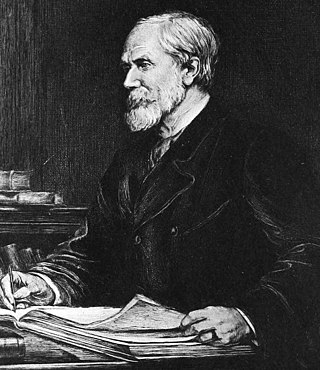
Henry Thomas Colebrooke FRS FRSE FLS was an English orientalist and botanist. He has been described as "the first great Sanskrit scholar in Europe".

Colonel Sir Henry Yule was a Scottish Orientalist and geographer. He published many travel books, including translations of the work of Marco Polo and Mirabilia by the 14th-century Dominican Friar Jordanus. He was also the compiler of a dictionary of Anglo-Indian terms, the Hobson-Jobson, with Arthur Coke Burnell.

Sir John William Kaye was a British military historian, civil servant and army officer in India. His major works on military history include a three-volume work on The History of the Sepoy War in India. This work was revised later by George Bruce Malleson and published in six volumes in 1890 as Kaye and Malleson's History of the Indian Mutiny.

The Royal Asiatic Society of Great Britain and Ireland, commonly known as the Royal Asiatic Society, was established, according to its royal charter of 11 August 1824, to further "the investigation of subjects connected with and for the encouragement of science, literature and the arts in relation to Asia." From its incorporation the society has been a forum, through lectures, its journal, and other publications, for scholarship relating to Asian culture and society of the highest level. It is the United Kingdom's senior learned society in the field of Asian studies. Fellows of the society are elected regularly and include highly accomplished and notable scholars of Asian studies; they use the post-nominal letters FRAS.

Horace Hayman Wilson was an English orientalist who was elected the first Boden Professor of Sanskrit at Oxford University.

James Prinsep was an English scholar, orientalist and antiquary. He was the founding editor of the Journal of the Asiatic Society of Bengal and is best remembered for deciphering the Kharosthi and Dhammalipi scripts of ancient India. He studied, documented and illustrated many aspects of numismatics, metallurgy, meteorology apart from pursuing his career in India as an assay master at the mint in Benares.

Sir George Abraham Grierson was an Irish administrator and linguist in British India. He worked in the Indian Civil Service but an interest in philology and linguistics led him to pursue studies in the languages and folklore of India during his postings in Bengal and Bihar. He published numerous studies in the journals of learned societies and wrote several books during his administrative career but proposed a formal linguistic survey at the Oriental Congress in 1886 at Vienna. The Congress recommended the idea to the British Government and he was appointed superintendent of the newly created Linguistic Survey of India in 1898. He continued the work until 1928, surveying people across the British Indian territory, documenting spoken languages, recording voices, written forms and was responsible in documenting information on 179 languages, defined by him through a test of mutual unintelligibility, and 544 dialects which he placed in five language families. He published the findings of the Linguistic Survey in a series that consisted of 19 volumes.
Fort William College was an academy of oriental studies and a centre of learning, founded on 18 August 1800 by Lord Wellesley, then Governor-General of British India, located within the Fort William complex in Calcutta. Wellesley started the Fort William College to train the European administrators. He backdated the statute of foundation to 4 May 1800, to commemorate the first anniversary of his victory over Tipu Sultan at Seringapatam. Thousands of books were translated from Sanskrit, Arabic, Persian, Bengali, Hindi, and Urdu into English at this institution.

James Atkinson was a surgeon, artist and Persian scholar — "a Renaissance man among Anglo-Indians".

Sir Henry Miers Elliot was an English civil servant and historian who worked with the East India Company in India for 26 years. He is most known for The History of India, as Told by Its Own Historians based on his works, published posthumously in eight volumes, between 1867–1877 in London.
William Francklin (1763–1839) was an English orientalist and army officer.
Charles Stewart (1764–1837), was a British orientalist who served in the Bengal Army from 1781 until 1808. He was assistant-professor of Persian at Fort William College, Calcutta from 1800 until 1806, while from 1807 until 1827, he was professor of Arabic, Persian, and Hindustani language at the East India College in Haileybury, India. During this time, he edited and translated oriental works.
Mihr-un-Nissa Begum, meaning "Sun among women", was a Mughal princess, the fifth daughter of Mughal Emperor Aurangzeb and his consort Aurangabadi Mahal.
Henry George Keene was an English employee of the East India Company, as soldier, civil servant, and orientalist. He was known as a Persian scholar, and also was a churchman and academic.

Heinrich Blochmann, known as Henry Ferdinand Blochmann, was a German orientalist and scholar of Persian language and literature who spent most of his career in India, where he worked first as a professor, and eventually as the principal at Calcutta Madrasa, now Aliah University in present Kolkata. He is also remembered for one of the first major English translations of Ain-i-Akbari, the 16th-century Persian language chronicle of Mughal emperor Akbar, published in 1873.

William Nassau Lees (1825–1889) was a British Army officer in India, known as an orientalist.

Henry George Keene was an English historian of medieval and modern India.
Shakr-un-Nissa Begum, also Shakr al-Nisa Begum was a Mughal princess, the daughter of Emperor Akbar.
John Tytler (1790–1837) was a Scottish medical officer of the East India Company and orientalist. He was also a significant educator of Indian students in Calcutta.
Maulawi Āghā Aḥmad ʿAlī was a 19th-century Bengali academic, historian and scholar of the Persian language. In addition to Persian, he also composed poetry in Urdu. He is seen as one of the greatest Persian scholars of Dhaka, and even Bengal as a whole.












